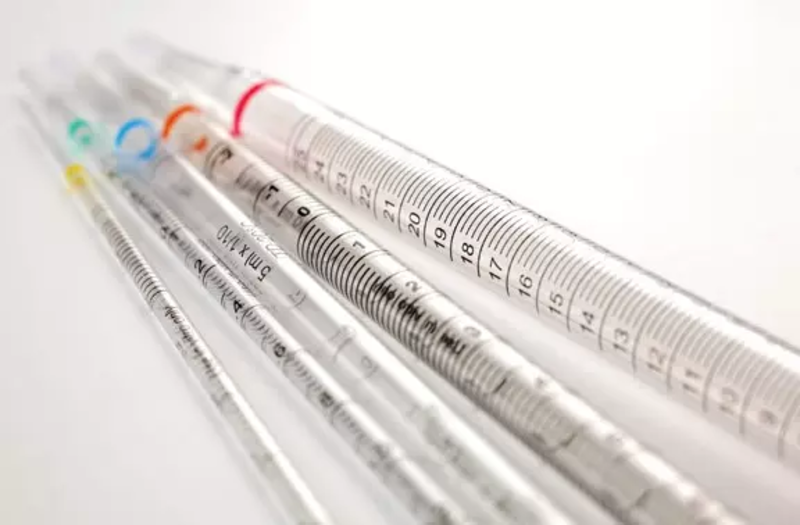Why is it important to use serological pipettes in a medical laboratory?
May 30 2018 /
When you work in a medical laboratory, you'll get exposed to different kinds of lab instruments and equipment. Therefore, anybody working in medical laboratories will be familiar with serological pipettes. These are laboratory instruments used for transferring liquid from one vessel to another. They have gradations along the sides. These are important for the measurement of the quantity of liquid that's dispensed or aspirated.
Take a close look at the pipette's top. Pipettes with double rings indicate that they are "blow out" pipettes. This means you must blow them out to acquire all of the liquid therein. Of course, since you use this in a medical laboratory, you should never blow out the liquid using your mouth. Instead, use a pipette pump.
In contrast to this type of pipette, we have the non-blow out types too. These are already regulated to permit the whole tip to get drained. It does leave a little bit of liquid at the tip and which you should not deliver. It's imperative to examine the label located on the pipette's body to determine its type.
Using serological pipettes and pipette pumps
The delicate nature for which pipettes are normally used makes them disposable items. You can purchase them either in single packaging or in bulk. Generally, you should always sterilize them first. Hand pumps are essential in working pipettes. Fortunately, there are many varieties available. Examples of these are the "Brinkmann-style" pump and the thumb roller type.
If you examine a pipette closely, you'll notice a plug made of cotton at the top. This serves as a sort of barrier to prevent overfilling. Every pipette should insert into the pump's bottom firmly and securely. If you use the Brinkmann-style pump, squeeze the pump's bulb. This will provide the necessary suction needed for drawing the liquid right into the pipette.
Use the small lever to regulate the discharging and loading of the pipette's contents. For the TC type of pipette, there is a small button made of rubber for you to press to blow the tip out.
Inside a Brinkmann-style pump, you'll find a standard valve system and syringe filter. These are replaceable parts. When the pump is no longer able to discharge, it's time to replace the filter. This indicates that overfilling has already contaminated it.
Aside from the Brinkmann-style pump, there are also the thumb roller pumps. These can have capacities of either 5, 10 or 25 ml. You hold these pumps the same way except that you use your thumb on the roller to elevate the piston. This will allow the solution to enter the pipette. To expel the solution, one can either reverse the rolling action or push down the piston.
Types of serological pipettes
You can find serological pipettes in almost all medical laboratories. They are primarily used to transfer liquids in milliliter volumes. You can purchase these pipettes either as glass or plastic. There are three main types of serological pipettes meant for specialized applications:
- Open-end - These open-ended pipettes are generally used when dealing with liquids of high-viscosity. The open-end feature makes it unique. This can easily and quickly allow the pipettes to draw and dispense the viscous liquids. The pipettes are usually made of polystyrene plastics. These are safer alternatives to the traditional glass pipettes. These pipettes are a great choice to handle the liquids they're designed for.
- Bacteriological - This type of pipette is ideal for use in the dairy industry, specifically in examining milk. Because of the nature of their function, these pipettes undergo gamma irradiation. This destroys any microorganisms and they usually come individually packaged. They're sterilized, non-pyrogenic and are only meant for single use. The pipette features a fiber filter. This helps prevent any liquid and fluid contamination of the samples by vapor.
- Aspirating - This type was solely designed for transferring and mixing liquids. They're widely used in many applications and procedures. The pipettes are non-pyrogenic and are of polystyrene plastic. These are a safer choice to the usual glass pipettes. They are also designed for single use. Also, these are transparent and do not have gradations.
Reading volumes and measuring using serological pipettes
Most of the serological pipettes used in laboratories are clearly labeled. Therefore, it's important to read the labels on the pipettes to make precise readings. It's also important for those concerned to know exactly how to read volumes and measure with them.
When you load the pipette, you can read the volume at the bottom part of the meniscus. This forms at the top of the liquid column. Take note of the arrangement of the numbers when trying to determine the volume. These are usually printed from tip to top, vice-versa or in both directions. When taking readings on volume, make sure to look at the pipette at eye level. Hold the pipette and at a right angle to the floor.
